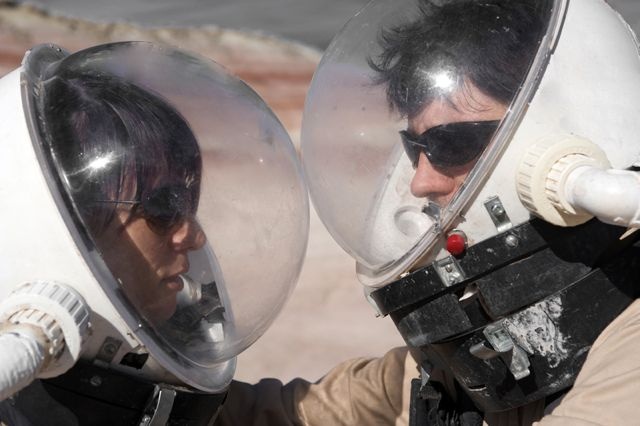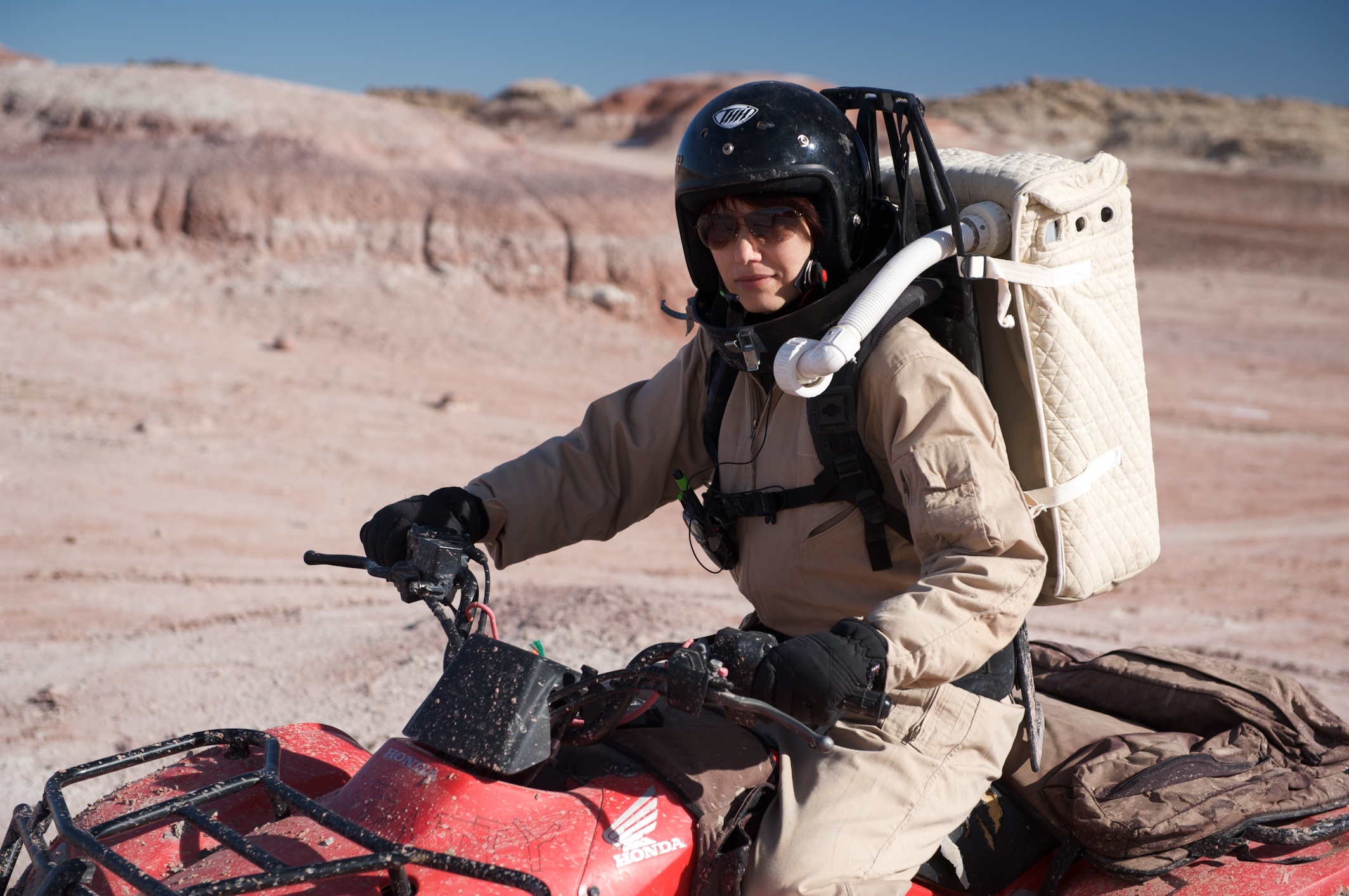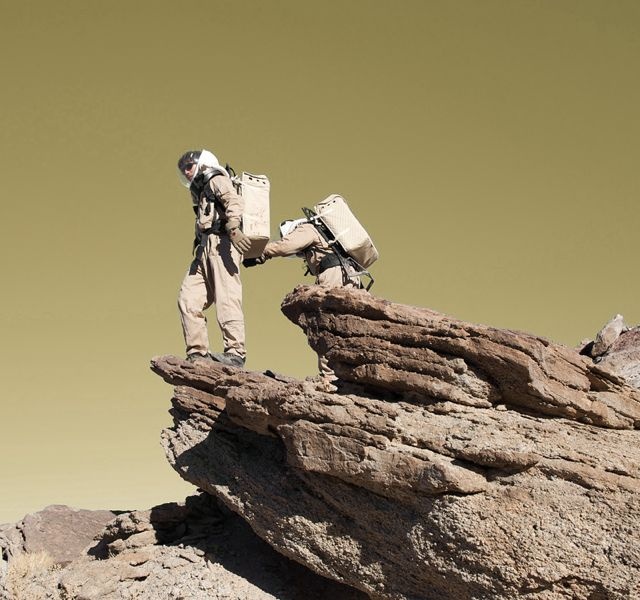
It's been a while since I wrote about life on Mars. That is because we were so busy adapting to our new environment! It's really not easy and we have to fill in for the crew's engineer, thank God there are two of us to do that job. 
Here are the two engineers of the mission, myself and Dragos Bratasanu who is also the journalist.
Waking up to another beautiful day on Mars is waking up with an exotic landscape. Looking on the wIt's very Martian! Because we are on a very tight recycling schedule, we brush our teeth with baking soda and we are only washing our hands with Oasis biodegradable soap. This gets transformed into gray water that is recycled through the green house.
We are subjected to a food study. We eat alternatively and have days for dried food that comes in huge cans and days for cooking when all we do is to rehydrate dried ingredients and then cook normally. So far we made bread, polenta, and a sort of naan bread.It's a very interesting experience that stretched all our talents to the maximum, including creativity whilst cooking.
Here is what we received from Mission Support:
From ancient Polynesian voyagers to present-day South Pole overwinter crews, lengthy sea voyages and polar exploration missions have all required specialized foods to sustain the crew over long periods of time in places with limited or no access to food in the local environment. Space missions continue this practice in a sense – present day astronauts consume a specialized diet too. Since cooking is nearly impossible in microgravity (search online for Sandra Magnus to learn the details) astronauts eat prepackaged rehydratable or ready-to-consume foods for all their meals. These meals are convenient to prepare and eat in microgravity and hundreds of different foods have been prepared for this purpose by space agencies worldwide. However, humans eating a restricted diet over a period of months ultimately experience “menu fatigue”. They tire of eating even the foods they enjoy, and their overall food intake declines, putting them at risk for nutritional deficiency, loss of bone and muscle mass, and reduced physical capabilities.
On a planetary surface mission, the presence of gravity makes cooking possible. The shelf life of properly packaged food ingredients is typically longer than that of pre-formulated foods, and bulk packaged ingredients require less packaging mass and generate less packaging waste than individual rehydratable meals. Furthermore, anecdotal evidence indicates that menu fatigue is far less significant when food is cooked on site from stored ingredients. With some skill and creativity on the part of the cook, an almost infinite variety of foods can be produced and customized to the needs and liking of the diners. Furthermore, the preparation and consumption of food is a social interaction for the crew, a creative process for the cook, and an important part of every human culture. The major disadvantage of cooking on a space mission is the requirement for crew labor and water for food preparation and cleanup. Crew time is very valuable, and the more time spent on housekeeping, maintenance, and food related tasks, the less is available for the mission’s exploratory or scientific goals. The labor requirement per crewmember meal varies with the size of the crew, the number of foods prepared and the equipment and ingredients available, but very little is known about the break-even point in crew size, at which cooking would become more labor-efficient than eating instant foods out of individual packages.
The MDRS food study is designed to simulate the food system on a real planetary mission and to compare the two types of food system – crew-cooked and pre-prepared – as thoroughly as possible in the context of a two week mission. The food acceptability, health and mood data you enter into your questionnaires, your skill and creativity as a cook, and your comments and suggestions to the food study investigators (who also have a NASA grant to study related issues) will have a real impact on the future of eating in space.
We are doing alright after one week of eating, the food is great but I do miss fresh stuff like apples or oranges or at least a leaf of lettuce. There are a lot of colours here on our Mars but green, the colour that defines life so much. I miss green and I dream of a green Mars one day.
are written in the first part of the day, after breakfast. We are on different times and everything has to be in overnight.
Whilst I write this blog, its 1 PM here on Mars on Tuesday, the 25th of January, 3 PM at the Mission Control Center, 10 PM in Romania and 9 AM in tomorrow morning in Wellington.
are sent every night until 8PM. Mission Control is online from 8 PM till 10 PM to answer to our daily issues and check on us. The reports are
Commander Check In
Commander detailed report
Journalist report (this is the one that includes pics too)
Engineering report
Chef's Report
Biology Report
EVA (Extra Vehicular Activity) Report
You can find all daily reports here Daily Reports: http://www.mdrs2011.com/Crew98.htm on the top of the page there is the link to the daily reports. I am sure that you will find some of these insights very interesting.
Almost every day some of the crew members go on EVAs for scientific or outreach purposes. EVA - extravehicular activities are real fun and for safety purposes we are wearing our normal helmets when we are driving the ATV's.

There are many procedures that are to be followed for an EVA that I will detail in one of my future posts.
The Martian sky is blue at dusk and dawn and orangy-creamy at noon.

On to Mars!